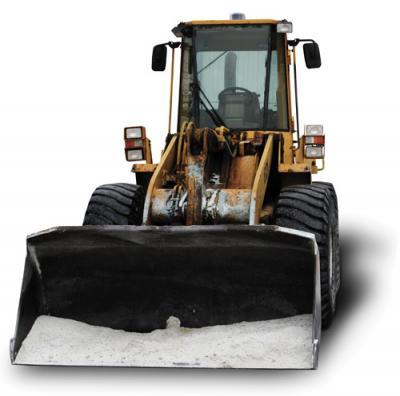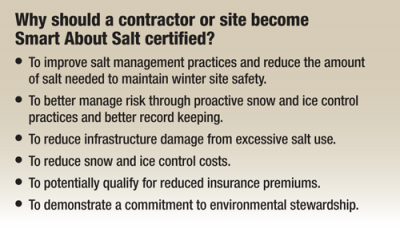August 6, 2013
Spreading the message
Salt reduction program takes a team approach to reach its goal

A snow and ice management program originally created to address elevated groundwater chloride loadings is providing multiple financial benefits to contractors as well as commercial facility managers. The Smart About Salt (SAS) program takes a three-pronged approach to controlling the amount of salt used on sidewalks and roads in winter, targeting snow and ice control contractors and facility operators as well as homeowners and tenants. Originally created by the Region of Waterloo (Ont.) in 2008, the program soon found advocates in Landscape Ontario, and the Building Operators and Managers Association of Ottawa. These organizations have invested in the program and together created the Smart About Salt Council to promote SAS and its benefits. While the program is based in Ontario, snow fighters from across Canada are invited to take advantage of its training and documentation requisites.
Encouraging clients to understand the science of SAS is one of the Smart About Salt Council’s goals for 2013. Leanne Lobe, executive director of the Smart About Salt Council, note, she has heard from contractors who know they have done their job properly and managed snow and ice effectively according to SAS recommendations, but property owner or managers will still call and ask for more salt to be placed on the clear pavement. She believes that SAS-certified contractors can best do what they are trained to do if the facility owners they work for are SAS-certified as well.
Lobe is taking her message on the road this summer and making presentations to several commercial building owner associations, introducing them to the benefits of being smart about salt. For one thing, she notes, it saves money by reducing the impact of excessive salt on infrastructure. Winter maintenance practices may be costing facilities more than just their snow control contracts. Excessive salt causes damage to landscape plants, concrete and asphalt, and can corrode steel and aluminum railings. Additionally, salty slush tracked inside a shopping mall or office lobby must be cleaned off floors and carpets constantly. Some of the more environmentally friendly salt options will actually accelerate damage to concrete infrastructure, so working with a contractor who is careful to apply only the right amount of product at the right time, following SAS best practices, can save thousands of dollars in infrastructure improvements by prolonging the maintenance and replacement costs of large infrastructure assets. Lobe says, “If you need to replace your carpet, you can get a quote for it and know how much it will cost, but you will not be able to measure the cost of a bad impression.” Lobe’s message is that hiring an SAS certified contractor will pay off in the long term in infrastructure repairs.
 An important reason for building managers to become SAS certified is that the program can reduce the company’s liability for slip and fall accidents. The SAS program takes a proactive approach to ice control. It encourages facility owners to spot and fix outdoor areas that might become winter hazards and require excess salt applications. On the other hand, if a contractor can show, through record keeping, that he notified the building owner about the hazard and has done everything within his power to control ice build-up in a specific area on the property, the building owner may be liable in the event of a slip and fall claim, if he did not correct the hazard when notified.
An important reason for building managers to become SAS certified is that the program can reduce the company’s liability for slip and fall accidents. The SAS program takes a proactive approach to ice control. It encourages facility owners to spot and fix outdoor areas that might become winter hazards and require excess salt applications. On the other hand, if a contractor can show, through record keeping, that he notified the building owner about the hazard and has done everything within his power to control ice build-up in a specific area on the property, the building owner may be liable in the event of a slip and fall claim, if he did not correct the hazard when notified.The comprehensive record-keeping requirements of the program are another reason to become SAS certified. While contractors have to track the weather and site conditions along with the amount and type of product they apply, the program encourages property owners to keep better records as well. Good record keeping is the best defense against any slip and fall claim. As proof, Lobe notes that, using the program’s documentation model, some SAS certified contractors have successfully defended against slip and fall claims.
The SAS website, www.smartaboutsalt.com is a wonderful resource for anyone looking for more information on the program, or how to become certified. Contractors can download brochures for their clients, or direct the facility manager to the website to see the benefits for themselves.
Last year, the Smart About Salt Council released a public service piece for consumers — the Get A Grip program. The Council uses this message to promote wearing proper footwear in the winter, and that high heels and dress shoes do not provide enough protection and traction during winter storms. The possibility of being hit with a slip and fall claim is the biggest reason for the over-application of salt at public facilities. The Get A Grip program is intended to remind people they are responsible for their own safety. Lobe says that the individuals who decide how much sidewalk salt to apply are often influenced by higher levels of management looking to avoid frivolous insurance claims. By making PSAs such as Get a Grip available for posting around offices, Lobe hopes to engage all the influencers in the SAS message about the unnecessary application of salt. Get a Grip posters can be downloaded for free at www.smartaboutsalt.com/getagrip.